Abstract
The most common bud sport trait in grapevines is the change in color of grape berry skin, and the color of grapes is mainly developed by the composition and accumulation of anthocyanins. Many studies have shown that MYBA is a key gene regulates the initiation of bud sport color and anthocyanin synthesis in grape peels. In the current study, we used berry skins of ‘Italia’, ‘Benitaka’, ‘Muscat of Alexandria’, ‘Flame Muscat’, ‘Rosario Bianco’, ‘Rosario Rosso’, and ‘Red Rosario’ at the véraison stage (10 weeks post-flowering and 11 weeks post-flowering) as research materials. The relative expressions of genes related to grape berry bud sport skin color were evaluated utilizing RNA-Seq technology. The results revealed that the expressions of the VvMYBA1/A2 gene in the three red grape varieties at the véraison stage were higher than in the three white grape varieties. The VvMYBA1/A2 gene is known to be associated with UFGT in the anthocyanin synthesis pathway. According to the results, VvMYBA1/A2 gene expression could also be associated with the expression of LDOX. In addition, a single gene (gene ID: Vitvi19g01871) displayed the highest expressions in all the samples at the véraison stage for the six varieties. The expression of this gene was much higher in the three green varieties compared to the three red ones. GO molecular function annotation identified it as a putative metallothionein-like protein with the ability to regulate the binding of copper ions to zinc ions and the role of maintaining the internal stable state of copper ions at the cellular level. High expression levels of this screened gene may play an important role in bud sport color of grape berry skin at the véraison stage.
1. Introduction
1.1. Bud Sport
Many of the fruits we eat every day are extremely heterozygous in nature [1]. The genomes of fruit trees or vines are highly heterozygous, and in order to adapt to the natural environment, some fruit trees gradually develop inbred incompatibility; as a result, some of the excellent characteristics of fruit trees are lost. Most varieties of fruit trees, such as peach, grape, and citrus, are self-compatible. Most varieties of apple, pear, sweet cherry, and other fruit trees are self-incompatible, while male sterility sometimes occurs in grapes. The VviINP1 gene was identified as related to male sterility in grapes [2]. In order to maintain the excellent properties of fruit during production, asexual propagation (cuttings, strips, and grafting) is used to maintain the exceptional characteristics of fruit [3]. Among cultivation processes, some different mutative traits are observed in similar plants [4], and some mutations are stable to inherit and are called bud sport [5].
Plant bud sport is related to somatic cell mutation that occurs in the cells of the meristem of plant buds, usually expressed on branches, leaves, flowers, and fruits. The phenotype displayed by the bud sport is significantly different from that of the rest of the plant [6]. In general, bud sport is produced by cell division in the apical meristem of plants, which is triggered by mutations in the stable somatic cells of the first single cell and then fills the cell layer and forms a stable chimera [7,8]. Mutation in this cell gradually fill some or all of the meristem tissue during later stages of growth, and the mutation can be transferred to offspring and can enable mutants to reproduce asexually [9]. Bud sport brings certain types of new traits in the plant itself, while the original qualities of the plant parents are retained, which shape a new mechanism of genetic mutation [10]. Different quantitative genetic studies have located the SDI 119 quantitative trait locus (QTL) on linkage group (LG) 18, explaining up to 70% of phenotypic variance in the 120 seed content parameters. Looking into the potentials of grape varieties for table purposes, mutation-breeding programs have started for other characteristics using chemical and physical mutagens. This is very important for plants because not only the quality of plants can be improved but also more economic value can be generated [11,12,13].
At present, researchers and growers have selected bud sport varieties that are related to the early ripening, peel color, fruit size, and disease resistance of fruit trees according to different needs [14]. For example, through natural selection, radiation, or colchicine treatment, bud sports varieties related to early fruit ripening and peel color have been found in apples and grapevines [15,16]. Bud sport varieties with enhanced disease resistance have been found in peaches, plums, strawberries, and citrus [17,18,19,20], and varieties with enlarged fruit and doubled chromosomes have been found in bananas and kiwifruit [21,22].
1.2. Fruit Color
In fruit trees or vines, especially in apples and grapevines, peel color acts as one of the criteria for judging the ripeness of fruit, which is an important indicator and quality parameter of fruits. Numerous examples of fruit berry skin and flesh types of bud sports were reported [23]; the most common type of bud sport changes the color of the flesh or berry skin. The color change in fruit is mainly related to the change in anthocyanin content. Anthocyanins are secondary metabolites of flavonoids. In plants, flavonoids are believed to have a variety of functions, including defense against light coercion. Anthocyanin compounds play an important reproductive role as attractants in plant–animal interactions [24]. Changes in the contents of anthocyanins and synthetic pathways have been fully studied through many plant experiments [25,26].
According to multifaceted verification, some key regulatory genes in the anthocyanin synthesis pathway were analyzed [27]. In the early stages of the flavonoid biosynthesis process, CHS generates chalcone from the 4-coumarinyl-CoA and malonyl-CoA substrates. Chalcone isomerase catalyzes the formation of naringenin, which is the main metabolite of other synthetic branches of this pathway. Downstream of the flavonoid biosynthetic pathway, anthocyanins and leucine are common key substrates for the synthesis of anthocyanins and proanthocyanidins (PAs). Leucoanthocyanidin dioxygenase/anthocyanidin synthase (LDOX/ANS) can convert leucoanthocyanins to anthocyanidins, and anthocyanidins can be further glycosylated by uridine diphosphate (UDP)-glucose to forming flavonoid-O-glycosyltransferase (UFGT). O-methyltransferases (OMTs) catalyze the formation of O-methylated anthocyanins, such as petunidin, peonidin, and malvidin [28,29].
Most of the fruit and skin colors of different fruits, especially grape berries, are associated with the MYB gene regulation of anthocyanins [30,31,32]. The biosynthesis of fruit anthocyanins is controlled by a unique branching of R2R3 MYB transcription factors. Normally, the MYB gene interacts with the bHLH transcription factor and the WD40 complex protein to regulate the synthesis pathway of anthocyanins [33]. Studies related to grapes and apples have shown that the change in fruit color is due to the insertion of a reverse transcriptional transposon in the promoter region of MYB or is a deletion of the MYB gene and its upstream alleles that causes the fruit peel or flesh color change. When the MYB gene does not show expression or its related sequence alleles are missing, fruit color cannot change to red, blue, or purple [34].
1.3. Grape Bud Sport
Grapes (Vitis vinifera L.) are one of the most popular fruits in the world and are usually consumed fresh, as well as in the form of several value-added products. The varieties of grape are diverse, including color, fruit size, fruit type, aroma, and other characteristics that show difference in quality. Among them, color is one of the most important quality attributes for consumers. From the beginning, people have used fresh grapes and wine as a source of transmission to spread grapes all over the world. However, with the development of breeding technology, grape breeding started, and many somatic mutations associated with the quality of grapes have been discovered. Many new grape varieties have been developed through bud sport selection.
In the following figure, the color of line under a variety represents grape peel color: green represents green varieties, red represents red varieties, and black represents black and purple varieties.
The white grape ‘Italia’ could sport into red grapes of the ‘Ruby Okuyama’ and ‘Benitaka’ varieties. The red grape ‘Okuyama Ruby’ and the white grape ‘Rosario Bianco’ were crossed to produce the red grape ‘Rosario Rosso’. The white grape ‘Muscat of Alexandria’ and the black-purple grape ‘Schiava Grossa’ were crossed to produce the black-purple grape ‘Muscat Hamburg’. The hybridization of ‘Bicane’ white grapes and ‘Muscat Hamburg’ black-purple grapes produced the white grape ‘Italia’ (Figure 1).
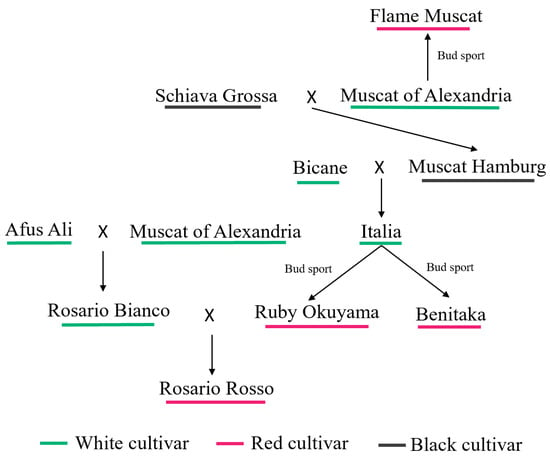
Figure 1.
‘Italia’ is associated with several grape bud sports and related relationship maps.
After thousands of years of natural hybridization and human selection, the color of the berry skins of grapes has become very diverse [35]. According to the presence or absence of anthocyanins in grape berry skin, which is divided into red and black or white varieties, this phenotype is controlled by a single gene locus [29]. There are four MYBs at this chromosome with two locations; at least two of these MYBs are mutated in white grapes. Either VvMYBA1 or VvMYBA2 (or both) can regulate berry peel color. For white grape, two mutations in the coding region of the VvMYBA2 allele cause its inactivation, while it is not transcribed in white grapes due to the presence of retrotransposons in the promoter region of VvMYBA1 [36,37]. This results in no accumulation of anthocyanins or very minute accumulation, and the berry skins and flesh color change from dark to light eventually. However, in some grape bud sport varieties, the deletion of the Gret1 retransposon restores the function of VvMYBA1, and this deletion makes the color of grape berry skins and flesh white to black or purple [38]. However, some studies have shown that, in yellow-green or white bud sports of ‘Cabernet Sauvignon’ [39], with the exception of VvMYBA1, its homologous genes of VvMYBA2r, VlMYBA1-1, VlMYBA1-2, and VlMYBA2 also regulate the synthesis of anthocyanins. In addition, there are functional and nonfunctional genes among these homologous genes and alleles [26]. Researchers found that, in white grapes, the allele of VvMYBA1 is homozygous, while the alleles of VvMYBA1 in red or black grapes are heterozygous [40]. It can be seen in many MYB-related genes in berries that play an important role in anthocyanin biosynthesis that the content of anthocyanins and the color of berry flesh and peels might be regulated by these genes.
1.4. Transcriptome Sequencing
Bud sport has been studied in many fruits; however, the mechanism of bud sport in grapes remains unclear. In order to understand the mechanism of berry peel color in relation bud sport, we utilize RNA-Seq technology to compare the ‘Italia’, ‘Benitaka’, ‘Muscat of Alexandria’, ‘Flame Muscat’, ‘Rosario Bianco’, and ‘Rosario Rosso’ varieties by selecting samples at 10 wpf (weeks post-flowering) and 11 wpf (12 samples in total). We conclude that, in addition to UFGT, the expression of the LDOX gene may also correlate with the expression of VvMYBA1/A2, and a new gene (gene ID: Vitvi19g01871) that exhibits the highest expression of all the detected genes in white varieties might play an important role at the véraison stage in ‘green-red’ bud sport berries.
2. Materials and Methods
2.1. Plant Materials
The research material (berries) used in this study was collected from the vineyard at the Zhengzhou fruit research institute (China) during 2020. The varieties used in the present research were ‘Italia’, ‘Benitaka’, ‘Muscat of Alexandria’, ‘Flame Muscat’, ‘Rosario Bianco’, and ‘Rosario Rosso’. The vines were 10 years old with ‘Y’-shaped tree forms. The berries of each cultivar were in the véraison stage, from 10 wpf (weeks post flowering) to 11 wpf. The red varieties showed notable change in berry color at 11 wpf (Figure 2). Three berries from the upper, middle, and lower parts of each cluster were selected from six uniform clusters. The berry skins were peeled off quickly and frozen in liquid nitrogen immediately. All frozen samples were stored at −80 °C for further analysis.
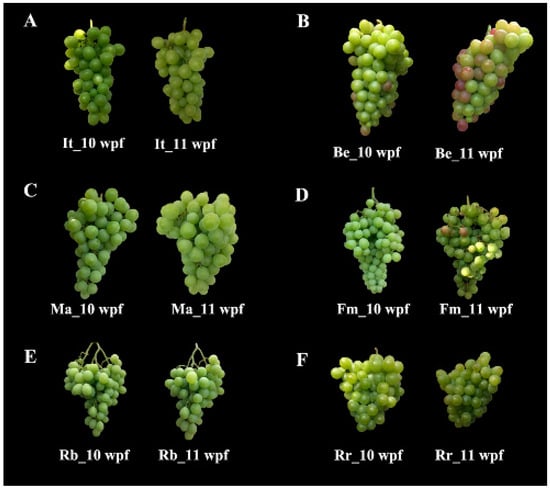
Figure 2.
Fruit clusters of six varieties during véraison period (10 wpf and 11 wpf). (A) ‘Italia’ berries at 10 and 11 wpf; (B) ‘Benitaka’ berries at 10 and 11 wpf; (C) ‘Muscat of Alexandria’ berries at 10 and 11 wpf; (D) ‘Flame Muscat’ berries at 10 and 11 wpf; (E) ‘Rosario Bianco’ berries at 10 and 11 wpf; (F) ‘Rosario Rosso’ berries at 10 and 11 wpf.
All the samples were allotted numbers as follows: It10 (‘Italia’ 10 wpf berries), It11 (‘Italia’ 11 wpf berries), Be10 (‘Benitaka’ 10 wpf berries), Be11 (‘Benitaka’ 11 wpf berries), Ma10 (‘Muscat of Alexandria’ 10 wpf berries), Ma11 (‘Muscat of Alexandria’ 11 wpf berries), Fm10 (‘Flame Muscat’ 10 wpf berries), Fm11 (‘Flame Muscat’ 11 wpf berries), Rb10 (‘Rosario Bianco’ 10 wpf berries), Rb11 (‘Rosario Bianco’ 11 wpf berries), Rb11 (‘Rosario Rosso’ 10 wpf berries), and Rr11 (‘Rosario Rosso’ 11 wpf berries) (as shown in Figure 2, respectively).
2.2. RNA Extraction and RNA-Seq
RNA was extracted from grape berry skins of different varieties using an RNA extract kit (Solebao Biotechnology Co., Ltd., Shanghai, China). The integrity of sample RNA was detected with agarose gel, the purity and concentration of RNA were detected with a NanoDrop-2000 instrument (Thermo Scientific, Waltham, MA, USA), and the RQN value was tested with Agilent5300 software. Follow-up experiments could be carried out when the RNA was not contaminated by impurities, such as pigment, protein, sugar, etc. The RQN ≥ 7, the brightness of 28/23S was greater than 18/16S, the RNA concentration ≥ 100 ng/uL, the OD260/280 = 1.8~2.2, the OD260/230 ≥ 2, and the total yield of RNA (>1 μg) met the requirements of two RNA libraries.
A Takara RT reagent kit (Takara, Shanghai, China) was used for cDNA and double-strand cDNA synthesis. RNA-Seq libraries were constructed using a TruSeq RNA sample prep kit v2 (Illumina, San Diego, CA, USA). The sequencing process was performed with an Illumina HiSeq 4000 SBS kit (300 cycles) system (Shanghai Majorbio Bio-pharm Biotechnology Co, Shanghai, China).
2.3. Transcriptome Sequencing and Analysis
SeqPrep (https://github.com/jstjohn/SeqPrep, accessed on 12 February 2022) and Sickle (https://github.com/najoshi/sickle, accessed on 12 February 2022) were used for trimming the adaptors of raw reads and quality control of the raw reads to obtain high-quality reads. The clean reads were aligned to a reference genome (reference genome version: 12X.v2, website source: https://urgi.versailles.inra.fr/Species/Vitis/Data-Sequences/Genome-sequences, accessed on 14 February 2022) with HISAT2 (http://ccb.jhu.edu/software/hisat2/index.shtml, accessed on 14 February 2022) software, and the mapped reads of each sample were assembled with StringTie (https://ccb.jhu.edu/software/stringtie/index.shtml?t=example, accessed on 15 February 2022). To identify DEGs (differential expression genes) between two different samples, the expression level of each transcript was calculated according to the transcripts per million reads (TPM) method. RSEM (http://deweylab.biostat.wisc.edu/rsem/) was used to quantify gene abundances. The DEG analysis was performed using DESeq2/DEGseq/EdgeR with Q values (adjusted p-value ≤ 0.05, DEGs with |log2FC| > 1 and Q value ≤ 0.05 (DESeq2 or EdgeR)/Q value ≤ 0.001 (DEGseq) that were considered to be significantly different expressed genes. The output of normalized TPM values and the DEG analysis were performed using the Majorbio cloud platform (Shanghai Majorbio Bio-Pharm Technology Co., Ltd.).
2.4. Statistical Analysis
A correlation analysis was performed among VvMYBA1, VvMYBA2, VvMYB5a, VvMYB5b, VvMYBPA1, and grape pericarp anthocyanin synthesis genes using the transcription group TPM value at the level of |r| > 0.7 and p < 0.05. Expression level was significantly related to the genes. Pearson’s correlation coefficient was used to measure the correlation between two random variables. The closer the Pearson value to 1, the higher the similarity of gene expression between samples, and the better the correlation between the samples.
SPSS v26.0 (Chicago, IL, USA) was used for the significance and correlation analysis of MYB-related regulatory genes related to anthocyanin synthesis structural genes data and correlation between anthocyanin synthesis structural genes and VvMYBA1 and VvMYBPA1 regulatory genes in two bud sport groups data.
3. Results
3.1. Quality Control Data Statistics
The total number of raw sequencings reads of each sample ranged from 41,748,704 to 48,476,130 among all the samples. After removing the low-quality reads, the average error rate of the sequencing bases of the clean reads after quality control was less than 0.026%. The percentage of the samples reaching Q20 quality reads was more than 97.74%, and the Q30 percentage was more than 93.32% among all the sequence data. The G and C base ratios were 45.96% and 47.01% of the total bases, respectively. The sequence alignment rates of clean reads matched with the reference genome ranged from 78.27% to 93.11% (Table 1).

Table 1.
RNA-Seq data quality of all 12 varieties.
3.2. Differentially Expressed Gene (DEG) Analysis
Through the differential expression analysis of the RNA-Seq data, 3124 DEGs were selected between It11 wpf (‘Italia’ grape skin samples at 11 weeks post-flowering) and It10 wpf. Compared to Be10 wpf, a total of 2707 DEGs were selected in Be11 wpf. In addition, 1766 DEGs were found between Ma11 wpf and Ma10 wpf, with 1716 DEGs between Fm11 wpf and Fm10 wpf. Rb11 wpf showed a total of 1640 DEG compared with Rb10 wpf, and Rr11 wpf showed 1579 DEGs compared with Rr10 wpf. The number of upregulated DEGs at the véraison stage (10 wpf to 11 wpf) was greater than the number of downregulated DEGs among the three white varieties of ‘Italia’, ‘Muscat of Alexandria’, and ‘Rosario Bianco’, while in red-colored varieties, ‘Benitaka’ and ‘Flame Muscat’ both showed lower upregulated DEG numbers at the véraison stage. Be10 wpf showed 1731 DEGs compared to It10 wpf, Fm10 wpf displayed 2790 DEGs compared to Ma10 wpf, and Rr10 wpf had 2962 DEGs compared to Rb10 wpf. For bud sport varieties in ‘Benitaka’, ‘Italia’, ‘Flame Muscat’, and ‘Muscat of Alexandria’, more upregulated DEG numbers were found at 10 wpf. Be11 wpf had a total of 2074 DEGs compared to It11 wpf, while 2000 DEGs were screened between Fm11 wpf and Ma11 wpf. Rr11 wpf had 3282 DEGs compared to Rb11 wpf. Among three comparisons of ‘Benitaka’ versus ‘Italia’, ‘Flame Muscat’ versus ‘Muscat of Alexandria’, and ‘Rosario Rosso’ versus ‘Rosario Bianco’, more downregulated DEG numbers were found at 11 wpf (Table 2).

Table 2.
The numbers of DEGs among difference comparison groups.
3.3. Correlation Analysis among Each Sample
The Pearson correlation coefficient between It10 wpf and It11 wpf was close to 1, and It10 showed a positive correlation with It11. The Pearson correlation coefficients between It11 and Ma11 and between It11 and Rb11 wpf were also close to 1. The three white varieties of ‘Italia’, ‘Muscat of Alexandria’, and ‘Rosario Bianco’ showed good correlation (>0.8) at 11 wpf as well. The correlation coefficients between Ma10 wpf and Ma11 wpf and between Rb10 wpf and Rb11 wpf were close to 1, with ‘Muscat of Alexandria’ and ‘Rosario Bianco’ closely correlated. The correlation between the three red varieties of ‘Benitaka’, ‘Flame Muscat’, and ‘Rosario Rosso’ was low between 10 wpf to 11 wpf (Figure 3).
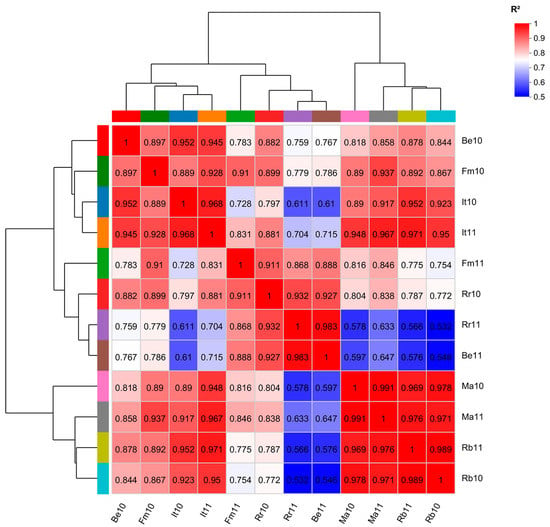
Figure 3.
Correlation heatmap of six varieties (three groups).
3.4. Gene Expression Level of VvMYBA1 in Berry Skins
The log2FC value was used to compare the expression levels of VvMYBA1 in the comparisons of the GC10_vs_RC10 group and the GC11_vs_RC11 group. The results showed that log2FC >7, which means that the expression levels of the VvMYBA1 gene in the three red varieties were much higher than those in three green varieties. In the comparison of the GC10_vs_GC11 group, the log2FC value was only 1.26, and VvMYBA1 just reached the differential expression level (if the screening parameter was log2FC > 1.5, then it was not significant). In the comparison of the RC10_vs_RC11 group, the log2FC value was 1.95, and the expression of the VvMYBA1 gene was significantly different (Figure 4).
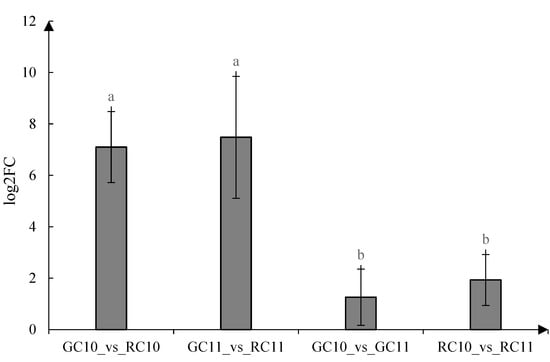
Figure 4.
Differences in VvMYBA1 expressions in red and white grape berry skins. ‘GC’ represents three green cultivars; ‘RC’ represents three red cultivars. a, b represent the significant level between the data (p < 0.05).
3.5. Anthocyanin-Synthesis-Related Gene Expression Analysis
Charenone synthase (CHS) is the first key enzyme of the flavonoid pathway. The gene expression in ‘Benitaka’ was higher at 10 wpf than at 11 wpf, and the gene expression level of Rr was lower at 10 wpf than 11 wpf. The expression level of the CHS-encoding gene VvCHS was significantly different at the véraison stage for ‘Benitaka’ and ‘Rosario Rosso’ compared with other varieties. The TPM values of VvCHS in berry skins at the véraison stage during the transition period of ‘Benitaka’ were higher than those of ‘Italia’ (Figure 5A). Chalcone isomerase (CHI) catalyzed the isomerization of chalcone rings to form colorless flavonoids, and there was no significant difference in the expression of the coding gene VvCHI between 10 wpf and 11 wpf for each cultivar (Figure 5B). Flavanone 3-hydroxylase (F3H) is one of the key enzymes in the biosynthetic pathway of anthocyanins, while F3H, F3’H, and F3′,5′H participate in the regulation of two branches of anthocyanin biosynthesis and the F3′H-controlled pathway for the synthesis of red anthocyanins. F3′,5′H, on the other hand, regulates the synthesis of blue-violet delphinidin. The expression level of the F3′H-encoding gene VvF3′H was low in each sample, and there was no significant difference between 10 wpf and 11 wpf (Figure 5C). The F3′,5′H-encoding genes of VvF3′ and 5′H were not expressed in It 10 wpf and Rr10 wpf, and the expressions of VvF3′, 5′H in the grape berry skins of the two mutated red varieties, ‘Benitaka’ and ‘Flame Muscat’, were higher than in ‘Italia’ and ‘Rosario Bianco’ (Figure 5D). In addition, the expression level of VvF3H in ‘Benitaka’ was obviously higher than that in ‘Italia’, and the expression of the F3H-encoded gene VvF3H at 10 wpf and 11 wpf for each sample was very low and displayed no difference in each cultivar (Figure 5E). The expression level of the FLS-encoding gene VvFLS showed greater variation in the skin of the ‘Benitaka’ during véraison.
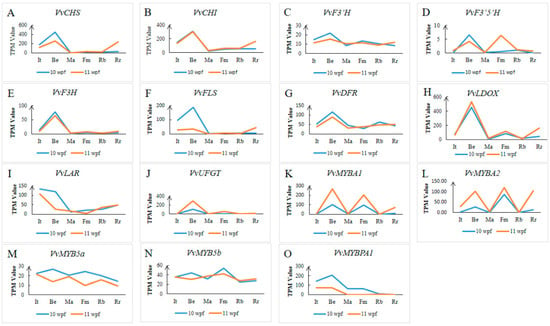
Figure 5.
Anthocyanin synthesis structure gene and regulatory gene expression analysis of six varieties. (A) CHS, chalcone synthase; (B) CHI, chalcone isomerase; (C) F3′H, flavonoid 30-hydroxylase; (D) F3′5′H, flavanone3′,5′-hydroxylase; (E) F3H, flavanone 3-hydroxylase; (F) FLS, flavonol synthase; (G) DFR, dihydroflavonol 4-reductase; (H) LDOX, leucoanthocyanidin dioxygenase; (I) LAR, leucoanthocyanidin reductase; (J) UFGT, anthocyanidin 3-O-glucosyltransferase; (K–O) MYBA1, MYBA2, MYB5a, MYB5b, MYBPA1, transcription factor encode genes, belonging to the R2R3 Myb family, which controls the last steps in the anthocyanins biosynthesis pathway.
Leucoanthocyanidin dioxygenase (LDOX) and UFGT successively catalyzed the oxidation of colorless proanthocyanidins to form colored delphinidin or anthocyanins and the glycosylation of catalytically unstable anthocyanins to form various stable anthocyanins. The expression levels of the LDOX-encoding gene VvLDOX, the UFGT-encoding gene VvUFGT, and the regulatory genes VvMYBA1 and VvMYBA2 in the pericarps of the three red varieties were higher than those of the white varieties. Both the VvUFGT and VvMYBA genes were hardly expressed in the three white varieties during the véraison period (Figure 5H,J–L). The expressions of regulatory genes VvMYBA5a and VvMYBPA1 in the 10 wpf grape berry skins of each cultivar were higher than at 11 wpf (Figure 5M,O).
3.6. Correlation Analysis between Anthocyanin-Synthesis-Related Structural Genes and VvMYBA1 and VvMYBPA1 Regulatory Genes among Bud Sport Varieties
In the ‘Italia’ vs. ‘Benitaka’ bud sport group, VvMYBA1 and VvUFGT showed a significant positive correlation, and VvMYBA1 may directly regulate VvUFGT expression to regulate anthocyanin synthesis. VvMYBA1 was positively correlated with VvCHS, VvCHI, VvF3H, and VvLDOX in the ‘Muscat of Alexandria’ vs. ‘Flame Muscat’ bud sport group, while VvMYBA1 was not significantly correlated with VvUFGT (Figure 6A,B). The mechanism of VvMYBA1 regulation of the anthocyanin synthesis pathway in the pericarp was different between the ‘Italia’ vs. ‘Benitaka’ bud sport group and the ‘Muscat of Alexandria’ vs. ‘Flame Muscat’ bud sport group. The gene expressions of VvMYBPA1 and VvFLS in the ‘Italia’ vs. ‘Benitaka’ bud sport group were positively correlated, and VvMYBPA1 may directly regulate the expression of VvFLS. There was no significant correlation between VvMYBPA1 and anthocyanin synthesis structural genes in the bud sport group of ‘Muscat of Alexandria’ vs. ‘Flame Muscat’, which may not be directly involved in the regulation of anthocyanin synthesis (Figure 6C,D).
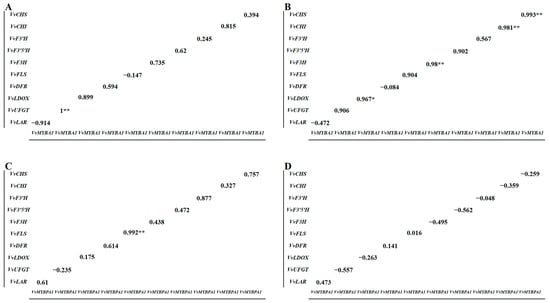
Figure 6.
Correlation between anthocyanin synthesis structural genes and VvMYBA1 and VvMYBPA1 regulatory genes in two bud sport groups. (A) Correlation between anthocyanin synthesis structural genes and VvMYBA1 regulatory gene in ‘Italia’ vs. ‘Benitaka’ bud sport group; (B) ‘Muscat of Alexandria’ vs. ‘Flame Muscat’ bud sport group anthocyanin synthesis structural genes and VvMYBA1 regulatory gene correlation; (C) correlation between anthocyanin synthesis structural genes and VvMYBPA1 regulatory gene in ‘Italia’ vs. ‘Benitaka’ bud sport group; (D) ‘Muscat of Alexandria’ vs. ‘Flame Muscat’ bud sport group anthocyanin synthesis structural genes associated with VvMYBPA1 regulatory gene. ‘*,**’ represents the two groups of data reached a significant level, ‘*’ represents p < 0.05, ‘**’ represents p < 0.01.
3.7. Correlation Analysis of MYB-Related Regulatory Genes and Anthocyanin Synthesis Structure
VvMYB5a and VvMYB5b were not significantly associated with structural genes in the anthocyanin synthesis pathway, which may not be directly involved in regulating the synthesis of anthocyanins. VvMYBPA1 showed significant correlations with VvCHS, VvF3′H, VvF3H, VvFLS, and VvLAR, which may directly regulate the flavonoid pathway, anthocyanin synthesis, flavonol synthesis, and catechol synthesis in the anthocyanin synthesis pathway. VvMYBA1 was positively correlated with VvF3′5′H, VvLDOX, and VvUFGT, which may be directly involved in regulating the synthesis of anthocyanins and regulating the UFGT catalytic formation of stable anthocyanin pathways. VvMYBA2 was not significantly associated with structural genes in the anthocyanin synthesis pathway (Table 3, Figure 7). Among these, the regulation of VvMYBA2 and VvMYB5a was not clear, while synthetic genes regulated by VvMYBPA1 and VvMYBA1 were clearly known.

Table 3.
MYB-related regulatory genes related to anthocyanin synthesis structural genes. ** represents p < 0.01.
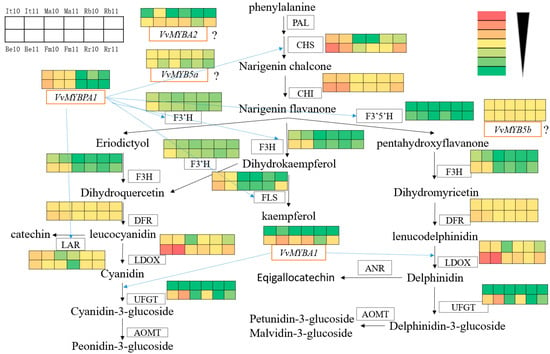
Figure 7.
The relationships between the expression color scale of anthocyanin synthesis structural genes and regulatory genes in grape peels and the regulation of the MYBA gene. The blue dotted arrows represent the structural genes in the anthocyanin synthesis pathway regulated by the regulatory gene; the ‘?’ indicates that the regulatory mechanism of the regulatory gene is not yet clear; the green-to-red color scale means the TPM values showed an increasing trend.
3.8. Screening of Genes Involved in the Regulation of Metal Ion Binding
When screening by sorting all gene expression levels (TPM values) in the three white grape varieties, a gene located on chromosome 19 (gene ID: Vitvi19g01871) was found to show the highest expression level. Its expression level was much higher than those of other genes, and the gene was highly expressed (almost the maximum) in the three red varieties. Interestingly, the expression levels of this gene in the pericarps of the three white the three red varieties during the same period were also different (Figure 8). From the comparison of 10 wpf and 11 wpf, this gene was upregulated at 11 wpf compared with 10 wpf in the white cultivar ‘Italia’, while the opposite was found in ‘Muscat of Alexandria’ and ‘Rosario Bianco’ (Figure 8). In the red varieties of ‘Benitaka’ and ‘Rosario Rosso’, the expression levels at 11 wpf were downregulated compared with 10 wpf, while the expression in ‘Flame Muscat’ was higher (Figure 8). According to the functional annotation, it was inferred that this gene encodes a metallothionein-like protein, which regulates the binding of copper ions and zinc ions. Copper ions are related to the synthesis of chlorophyll, which may have a certain impact on the change in peel color at the véraison stage.
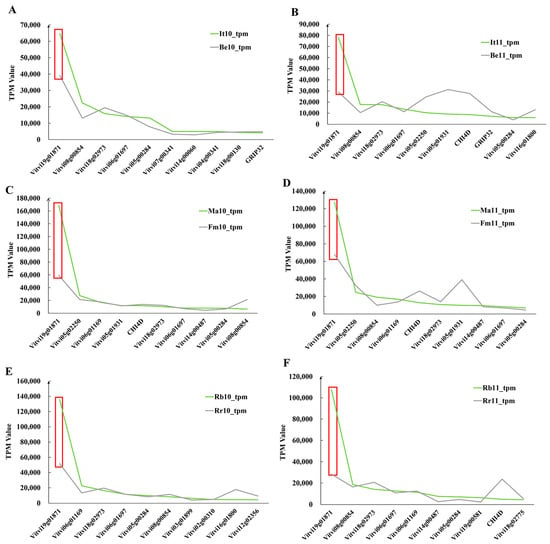
Figure 8.
(A) ‘Italia’ ‘Benitaka’ TPM value almost top 10 of gene expression 10 wpf; (B) ‘Italia’ ‘Benitaka’ TPM value almost top 10 of gene expression 11 wpf; (C) ‘Muscat of Alexandria’ ‘Flame Muscat’ TPM value almost top 10 of gene expression 10 wpf; (D) ‘Muscat of Alexandria’ ‘Flame Muscat’ TPM value almost top 10 of gene expression 11 wpf; (E) ‘Rosario Bianco’ ‘Rosario Rosso’ TPM value almost top 10 of gene expression 10 wpf; (F) ‘Rosario Bianco’ ‘Rosario Rosso’ Top TPM value almost top 10 of gene expression 11 wpf. The green line represents the TPM values of white cultivars; the black line represents the TPM values of red and black cultivar.
4. Discussion
In recent years, it has been observed that many important fruit varieties are selected by bud sport [41,42]. According to statistics, there have been thousands of bud sport types on fruit trees, and some fruit trees can form a variety of bud sports. Due to the particularity of each bud sport, it brings certain characteristics in germplasm resources during fruit production and breeding. Therefore, this is an important approach used in the breeding of fruit crops.
The present study revealed that VvMYBA1 showed elevated expression levels in the three red sport varieties at 10 wpf compared to three white varieties. In addition, after 11 wpf there were significantly higher VvMYBA1 gene expression levels compared with the white cultivar grapes (Figure 4B). The VvMYBA1 gene was proved to be a key transcription factor regulating color change in grape berry skins [43]. The VvMYBA1 gene was expressed only in red berries, while it was hardly expressed in white berries (Figure 5K).
According to a correlation analysis, the majority of genes or enzymes related to the anthocyanin synthesis pathway were significantly correlated with VvMYBPA1 and VvMYBA1 (Table 3). Among them, five genes showed significant correlations with various genes, such as VvMYBPA1, VvCHS, VvF3′H, VvF3H, VvFLS, and VvLAR. Significant correlations of VvF3′5′H, VvLDOX, and VvUFGT with VvMYBA1 were observed in our study.
The expression of the flavonoid 3-O-glucosyltransferase (UFGT) gene is essential for anthocyanin biosynthesis in grapes [44]. The VvMYBA1 gene normally regulates the expression of VvUFGT, a key upstream gene of anthocyanin synthesis [45] considered to be the last step for catalyzing anthocyanin synthesis in the anthocyanin biosynthesis pathway [46], and both are very important in the formation of grape skin color. The RNA-Seq results indicated that the expression trends of VvUFGT in the three red varieties were consistent; among them, the expression level in ‘Benitaka’ was significantly higher than in the other two varieties and was not expressed in white grape varieties (Figure 5J). The above results are consistent with the results of a previous study conducted on ‘Italia’, ‘Benitaka’ and ‘Flame Muscat’ [5]. The Pearson’s correlation analysis showed that VvMYBA1 and VvUFGT were highly correlated with the same expression trend (Figure 5J,K). The results also indicated that VvMYBA1 positively regulated the VvUFGT gene and played an important role in the biosynthesis of anthocyanins.
According to previous reports on anthocyanin synthesis in apples and bilberries, it was found that MYBPA1 could also regulate the expression of UFGT [47]. In this experiment, the correlation between these two genes was not high. This may explain why, among the three groups of varieties (the ‘Italia’ vs. ‘Benitaka’ group, the ‘Muscat of Alexandria’ vs. ‘Flame Muscat’ group, and the ‘Rosario Bianco’ vs. ‘Rosario Rosso’ group), MYBPA1 was not a key transcription factor regulating UFGT and the anthocyanin biosynthesis pathway. Its specific regulatory mechanism still needs further study.
MYBPA1 plays an important role in the anthocyanin biosynthesis pathway, and the expression of MYBPA1 is positively correlated with anthocyanin accumulation [48]. In blue bilberries, the MYBPA1 and MYBA transcription factors can activate the expression of DFR and ANS genes in the anthocyanin biosynthesis pathway, which are considered key genes for anthocyanin biosynthesis [49]. In this study, the expression levels of the VvMYBPA1 gene in the two groups of bud sport varieties of ‘Italia’ vs. ‘Benitaka’ and ‘Muscat of Alexandria’ vs. ‘Flame Muscat’ were higher at 10 wpf compared with 11 wpf, while this gene was not expressed in the ‘Rosario Bianco’ vs. ‘Rosario Rosso’ group (Figure 5O). The expression trends of five structural genes (VvCHS, VvF3’H, VvF3H, VvFLS, and VvLAR, Table 3) related to VvMYBPA1 were different in the three groups of tested varieties (Figure 5A–E,I). The phylogenetic analysis depicted that the flavonoid-related R2R3 MYBs of VmMYBPA1 and VvMYBPA1 belonged to the same group. VmMYBPA1 could regulate the expression of CHS and significantly regulated the expression of the F3′5′H gene, while VmMYBPA1 expression was significantly decreased in white mutant berries compared with blueberries [50], which indicates that it was related to anthocyanin biosynthesis. The expression level of MYBPA1 is associated with the accumulation of proanthocyanidins (PA) during the early development of grape berries. The expression level of MYBPA1 was lower before the véraison stage and peaked at two weeks following the véraison stage, later showing a low expression level. MYBPA1 activates the promoters of LAR and ANR in grapes [51]. The expression of VvMYBPA1 was opposite to that of VmMYBPA1, as expressed in ‘Italia’. This is in contrast to previous studies showing no expression observed in white grape varieties. A previous study also found that VvMYBPA1 could also be expressed in seeds [52]. The above results might indicate that the pathway or regulation mechanism of the MYB gene in anthocyanin synthesis is different in diverse species.
The gene expression analysis showed that the expression of VvLDOX was consistent with the expression trends of VvMYBA1 and VvUFGT in other test materials, except for in ‘Italia’ (Figure 5H,J–K). LDOX has a unique expression pattern in the biosynthesis of anthocyanin in grape peels, and its expression levels were very high in red or black peels, which was related to the content of anthocyanin. UFGT is present in many tissues of grape, as well as in the skins of white and red grape varieties, while the expression of LDOX is not as absolute as UFGT [53]. VvMYBPA1 was found to activate VvLDOX expression in grapes [49], and this result suggested that the expression of VvLDOX in ‘Italia’ may be related to the regulation of VvMYBPA1, while there was no significant correlation between VvMYBPA1 and VvLDOX.
In addition to the above results, an interesting point found in this study was the gene located on chromosome number 19 (Gene ID: Vitvi19g01871). The gene expression levels (TPM values) of green varieties at 10 weeks and 11 weeks post-flowering were between 64,711–168,489 and 78,173–127,381, respectively. The expression levels of red grape varieties at 10 weeks and 11 weeks post-flowering were between 39,130–59,249 and 28,319–67,849, respectively. The expression levels of this gene in green varieties were much higher than those in red varieties, as well as much higher than all the other differentially expressed genes (Figure 8). The gene was annotated by GO molecular gene function as a metallothionein-like protein that regulates the binding of copper ions to zinc ions. Copper ions play an important role in the redox of plant respiration and are related to chlorophyll synthesis, which is important for photosynthesis. Increased photosynthesis and chlorophyll lead to excessive chlorophyll accumulation in grape peel cells. However, its mechanism of action in the process of bud sport peel color and anthocyanin synthesis is still unclear, and the function of this gene needs to be further verified at molecular or cellular levels.
5. Conclusions
In this study, it was found that MYBA1/2 and MYBPA1, the key genes involved in anthocyanin synthesis in grapes, were highly expressed in red grape varieties, and their expression levels in white grapes were significantly lower than in red grapes. The expressions of UFGT and LDOX genes were positively correlated with the key peel-color-related gene of MYBA. A newly discovered gene (gene ID: Vitvi19g01871) in this study may play a key regulatory role in grape skin coloration.
Author Contributions
Experimental design, Y.X. and W.W.; data curation, H.F. and L.Y.; figures and table making, Y.H. and Z.D.; writing, H.F. and W.W.; manuscript review and editing, M.K.-U.-R. and G.Y. All authors have read and agreed to the published version of the manuscript.
Funding
This work was supported by grants from the National Natural Science Foundation of China Youth Fund (No. 32002015), the Natural Science Foundation Youth Fund of Hunan Province (2021JJ40252), and the Hunan Provincial Department of Education Scientific Research Project—General Project (19C0926).
Data Availability Statement
Not applicable.
Conflicts of Interest
The authors declare no conflict of interest.
References
- Hansche, P.E.; Beres, W. Genetic remodeling of fruit and nut trees to facilitate cultivar improvement. HortScience 1980, 15, 710–715. [Google Scholar] [CrossRef]
- Massonnet, M.; Cochetel, N.; Minio, A.; Vondras, A.M.; Lin, J.; Muyle, A.; Garcia, J.F.; Zhou, Y.; Delledonne, M.; Riaz, S.; et al. The genetic basis of sex determination in grapes. Nat. Commun. 2020, 11, 2902. [Google Scholar] [CrossRef] [PubMed]
- Foster, T.M.; Aranzana, M.J. Attention sports fans! The far-reaching contributions of bud sport mutants to horticulture and plant biology. Hortic. Res. 2018, 5, 44. [Google Scholar] [CrossRef] [PubMed]
- Wu, B.; Li, N.; Deng, Z.; Luo, F.; Duan, Y. Selection and evaluation of a thornless and HLB-tolerant bud-sport of pummelo citrus with an emphasis on molecular mechanisms. Front. Plant Sci. 2021, 12, 739108. [Google Scholar] [CrossRef]
- Du, X.; Wang, Y.; Liu, M.; Liu, X.; Jiang, Z.; Zhao, L.; Tang, Y.; Sun, Y. The assessment of epigenetic diversity, differentiation, and structure in the ‘Fuji’ mutation line implicates roles of epigenetic modification in the occurrence of different mutant groups as well as spontaneous mutants. PLoS ONE 2020, 15, e0235073. [Google Scholar] [CrossRef]
- Azuma, A.; Kobayashi, S.; Goto-Yamamoto, N.; Shiraishi, M.; Mitani, N.; Yakushji, H.; Koshita, Y. Color recovery in berries of grape (Vitis vinifera L.) ‘Benitaka’, a bud sport of ‘Italia’, is caused by a novel allele at the VvmybA1 locus. Plant Sci. 2009, 176, 470–478. [Google Scholar] [CrossRef]
- Szymkowiak, E.J.; Sussex, I.M. What chimeras can tell us about plant development. Annu. Rev. Plant Biol. 1996, 47, 351–376. [Google Scholar] [CrossRef]
- Stewart, R.N.; Meyer, F.G.; Dermen, H. Camellia ‘Daisy Eagleson’ a graft chimera of Camellia sasanqua and C. japonica. Am. J. Bot. 1972, 59, 515–524. [Google Scholar] [CrossRef]
- Darwin, C. The Variation of Animals and Plants under Domestication (Cambridge Library Collection—Darwin, Evolution and Genetics, pp. I–Ii); Cambridge University Press: Cambridge, UK, 2010. [Google Scholar] [CrossRef]
- Franks, T.; Botta, R.; Thomas, M.R.; Franks, J. Chimerism in grapevines: Implications for cultivar identity, ancestry and genetic improvement. Theor. Appl. Genet. 2002, 104, 192–199. [Google Scholar] [CrossRef]
- Liu, G.; Li, B.; Hu, P.; Zhou, G. Analysis of differences in mineral element content of early maturation of navel orange and its parent seedlings. Trop. Agric. Sci. 2017, 37, 21–25. [Google Scholar]
- Carolina, R.; Rafael, T.P.; Nuria, M.; Nieves, D.; José, A.V.; Cécile, M.; Thierry, L.; Javier, I.; Manuel, T.; Juan, V.; et al. The major origin of seedless grapes is associated with a 4 missense mutation in the MADS-box gene VviAGL11. Plant Physiol. 2018, 177, 1234–1253. [Google Scholar]
- Tetali, S.; Karkamkar, S.P.; Phalake, S.V. Mutation breeding for inducing seedlessness in grape variety ARI 516. Int. J. Minor Fruits Med. Aromat. Plants 2020, 6, 67–71. [Google Scholar]
- Visser, T.; Verhaegh, J.J.; De Vries, D.P. Pre-selection of compact mutants induced by X-ray treatment in apple and pear. Euphytica 1971, 20, 195–207. [Google Scholar] [CrossRef]
- Kuksova, V.B.; Piven, N.M.; Gleba, Y.Y. Somaclonal variation and in vitro induced mutagenesis in grapevine. Plant Cell Tissue Organ Cult. 1997, 49, 17–27. [Google Scholar] [CrossRef]
- Hamill, S.D.; Smith, M.K.; Dodd, W.A. In vitro induction of banana autotetraploids by colchicine treatment of micropropagated diploids. Aust. J. Bot. 1992, 40, 887–896. [Google Scholar] [CrossRef]
- Predieri, S.; Gatti, E. Effects of gamma radiation on microcuttings of plum (Prunus salicina Lindl.)‘Shiro’. Adv. Hortic. Sci. 2000, 14, 7–11. [Google Scholar]
- Hashmi, G.P.; Hammerschlag, F.A.; Huettel, R.N. Growth, development, and response of peach somaclones to the root-knot nematode, Meloidogyne incognita. J. Am. Soc. Hortic. Sci. 1995, 120, 932–937. [Google Scholar] [CrossRef]
- Wu, J.H.; Ferguson, A.R.; Murray, B.G. Manipulation of ploidy for kiwifruit breeding: In vitro chromosome doubling in diploid Actinidia chinensis Planch. Plant Cell Tissue Organ Cult. 2011, 106, 503–511. [Google Scholar] [CrossRef]
- Takahashi, H. Breeding of strawberry resistant to Alternaria black spot of strawberry varieties (Alternaria althernata strawberry pathotype). Bul. Akita Pref. Coll. Agri. 1993, 19, 1–44. [Google Scholar]
- Ge, H.; Li, Y.; Fu, H.; Fu, H.; Luo, L.; Li, R.; Deng, Z. Production of sweet orange somaclones tolerant to citrus canker disease by in vitro mutagenesis with EMS. Plant Cell Tissue Organ Cult. 2015, 123, 29–38. [Google Scholar] [CrossRef]
- Shamel, A.D.; Pomeroy, C.S. Bud mutations in horticultural crops. J. Hered. 1936, 27, 487–494. [Google Scholar] [CrossRef]
- Lamo, K.; Bhat, D.J.; Kour, K.; Pratap, S. Mutation studies in fruit crops: A review. Int. J. Curr. Microbiol. Appl. Sci. 2017, 6, 3620–3633. [Google Scholar] [CrossRef]
- Allan, A.C.; Hellens, R.P.; Laing, W.A. MYB transcription factors that colour our fruit. Trends Plant Sci. 2008, 13, 99–102. [Google Scholar] [CrossRef] [PubMed]
- Winkel-Shirley, B. Flavonoid biosynthesis. A colorful model for genetics, biochemistry, cell biology, and biotechnology. Plant Physiol. 2001, 126, 485–493. [Google Scholar] [CrossRef] [PubMed]
- Grotewold, E. The genetics and biochemistry of floral pigments. Annu. Rev. Plant Biol. 2006, 57, 761–780. [Google Scholar] [CrossRef]
- Jaakola, L. New insights into the regulation of anthocyanin biosynthesis in fruits. Trends Plant Sci. 2013, 18, 477–483. [Google Scholar] [CrossRef]
- Tohge, T.; de Souza, L.P.; Fernie, A.R. Current understanding of the pathways of flavonoid biosynthesis in model and crop plants. J. Exp. Bot. 2017, 68, 4013–4028. [Google Scholar] [CrossRef]
- Jun, J.H.; Xiao, X.; Rao, X.; Dixon, R. Proanthocyanidin subunit composition determined by functionally diverged dioxygenases. Nat. Plants 2018, 4, 1034–1043. [Google Scholar] [CrossRef]
- Gu, C.; Liao, L.; Zhou, H.; Wang, L.; Deng, X.; Han, Y. Constitutive activation of an anthocyanin regulatory gene PcMYB10. 6 is related to red coloration in purple-foliage plum. PLoS ONE 2015, 10, e0135159. [Google Scholar] [CrossRef]
- Sun, B.; Zhu, Z.; Cao, P.; Chen, H.; Chen, C.; Zhou, X.; Mao, Y.; Lei, J. Purple foliage coloration in tea (Camellia sinensis L.) arises from activation of the R2R3-MYB transcription factor CsAN1. Sci. Rep. 2016, 6, srep32534. [Google Scholar] [CrossRef]
- Zhou, Y.; Zhou, H.; Lin-Wang, K.; Vimolmangkang, S.; Espley, R.; Wang, L.; Allan, A. Transcriptome analysis and transient transformation suggest an ancient duplicated MYB transcription factor as a candidate gene for leaf red coloration in peach. BMC Plant Biol. 2014, 14, 388. [Google Scholar] [CrossRef] [PubMed]
- Matus, J.T.; Aquea, F.; Arce-Johnson, P. Analysis of the grape MYB R2R3 subfamily reveals expanded wine quality-related clades and conserved gene structure organization across Vitis and Arabidopsis genomes. BMC Plant Biol. 2008, 8, 83. [Google Scholar] [CrossRef] [PubMed]
- Zhang, L.; Hu, J.; Han, X.; Li, J.; Gao, Y.; Zhang, G.; Tian, Y. A high-quality apple genome assembly reveals the association of a retrotransposon and red fruit colour. Nat. Commun. 2019, 10, 1494. [Google Scholar] [CrossRef] [PubMed]
- Boss, P.K.; Davies, C.; Robinson, S.P. Expression of anthocyanin biosynthesis pathway genes in red and white grapes. Plant Mol. Biol. 1996, 32, 565–569. [Google Scholar] [CrossRef] [PubMed]
- Kobayashi, S.; Goto-Yamamoto, N.; Hirochika, H. Retrotransposon-induced mutations in grape skin color. Science 2004, 304, 982. [Google Scholar] [CrossRef] [PubMed]
- Walker, A.R.; Lee, E.; Bogs, J.; McDavid, D.; Robinson, S.; Thomas, M. White grapes arose through the mutation of two similar and adjacent regulatory genes. Plant J. 2007, 49, 772–785. [Google Scholar] [CrossRef] [PubMed]
- Lijavetzky, D.; Ruiz-García, L.; Cabezas, J.A.; Andres, M.T.; Bravo, G.; Lbanez, A.; Cabello, F. Molecular genetics of berry colour variation in table grape. Mol. Genet. Genom. 2006, 276, 427–435. [Google Scholar] [CrossRef]
- Walker, A.R.; Lee, E.; Robinson, S.P. Two new grape varieties, bud sports of Cabernet Sauvignon bearing pale-coloured berries, are the result of deletion of two regulatory genes of the berry colour locus. Plant Mol. Biol. 2006, 62, 623–635. [Google Scholar] [CrossRef]
- This, P.; Lacombe, T.; Cadle-Davidson, M.; Owens, C.L. Wine grape (Vitis vinifera L.) color associates with allelic variation in the domestication gene VvmybA1. Theor. Appl. Genet. 2007, 114, 723–730. [Google Scholar] [CrossRef]
- Granhall, I. Spontaneous and induced bud mutations in fruit trees. Acta Agric. Scand. 1954, 4, 594–600. [Google Scholar] [CrossRef]
- Alexander, V. Breeding for Ornamentals: Classical and Molecular Approaches; Springer Science & Business Media: Rehovot, Israel, 2002. [Google Scholar]
- Kobayashi, S.; Ishimaru, M.; Hiraoka, K.; Honda, C. Myb-related genes of the Kyoho grape (Vitis labruscana) regulate anthocyanin biosynthesis. Planta 2002, 215, 924–933. [Google Scholar]
- He, P.; Li, L.; Wang, H.; Chang, Y. An RNA-Seq analysis of the peach transcriptome with a focus on genes associated with skin colour. Czech J. Genet. Plant Breed. 2019, 55, 166–169. [Google Scholar] [CrossRef]
- Azuma, A.; Kono, A.; Sato, A. Simple DNA marker system reveals genetic diversity of MYB genotypes that determine skin color in grape genetic resources. Tree Genet. Genomes 2020, 16, 29. [Google Scholar] [CrossRef]
- Bogs, J.; Jaffé, F.W.; Takos, A.M.; Walker, A.R.; Robinson, S.P. The grapevine transcription factor VvMYBPA1 regulates proanthocyanidin synthesis during fruit development. Plant Physiol. 2007, 143, 1347–1361. [Google Scholar] [CrossRef]
- Wang, N.; Qu, C.; Jiang, S.; Chen, Z.; Xu, H.; Fang, H.; Su, M.; Zhang, J.; Wang, Y.; Liu, W.; et al. The proanthocyanidin-specific transcription factor MdMYBPA1 initiates anthocyanin synthesis under low-temperature conditions in red-fleshed apples. Plant J. 2018, 96, 39–55. [Google Scholar] [CrossRef] [PubMed]
- Primetta, A.K.; Karppinen, K.; Riihinen, K.R.; Jaakola, L. Metabolic and molecular analyses of white mutant Vaccinium berries show down-regulation of MYBPA1-type R2R3 MYB regulatory factor. Planta 2015, 242, 631–643. [Google Scholar] [CrossRef] [PubMed]
- Günther, C.S.; Dare, A.P.; McGhie, T.K.; Deng, C.; Lafferty, D.J.; Plunkett, B.J.; Grierson, E.R.; Turner, J.L.; Jaakola, L.; Albert, N.W.; et al. Spatiotemporal modulation of flavonoid metabolism in blueberries. Front. Plant Sci. 2020, 11, 545. [Google Scholar] [CrossRef] [PubMed]
- Karppinen, K.; Lafferty, D.J.; Albert, N.W.; Mikkola, N.; McGhie, T.; Allan, A.C.; Afzal, B.M.; Häggman, H.; Espley, R.V.; Jaakola, L. MYBA and MYBPA transcription factors co-regulate anthocyanin biosynthesis in blue-coloured berries. New Phytol. 2021, 232, 1350–1367. [Google Scholar] [CrossRef] [PubMed]
- Liu, Y.; Shi, Z.; Maximova, S.N.; Payne, M.J.; Guiltinan, M.J. Tc-MYBPA is an Arabidopsis TT2-like transcription factor and functions in the regulation of proanthocyanidin synthesis in Theobroma cacao. BMC Plant Biol. 2015, 15, 160. [Google Scholar] [CrossRef]
- Terrier, N.; Torregrosa, L.; Ageorges, A.; Vialet, S.; Verriès, C.; Cheynier, V.; Romieu, C. Ectopic expression of VvMybPA2 promotes proanthocyanidin biosynthesis in grapevine and suggests additional targets in the pathway. Plant Physiol. 2009, 149, 1028–1041. [Google Scholar] [CrossRef] [PubMed]
- Boss, P.K.; Davies, C.; Robinson, S.P. Anthocyanin composition and anthocyanin pathway gene expression in grapevine sports differing in berry skin colour. Aust. J. Grape Wine Res. 1996, 2, 163–170. [Google Scholar] [CrossRef]
Disclaimer/Publisher’s Note: The statements, opinions and data contained in all publications are solely those of the individual author(s) and contributor(s) and not of MDPI and/or the editor(s). MDPI and/or the editor(s) disclaim responsibility for any injury to people or property resulting from any ideas, methods, instructions or products referred to in the content. |
© 2023 by the authors. Licensee MDPI, Basel, Switzerland. This article is an open access article distributed under the terms and conditions of the Creative Commons Attribution (CC BY) license (https://creativecommons.org/licenses/by/4.0/).